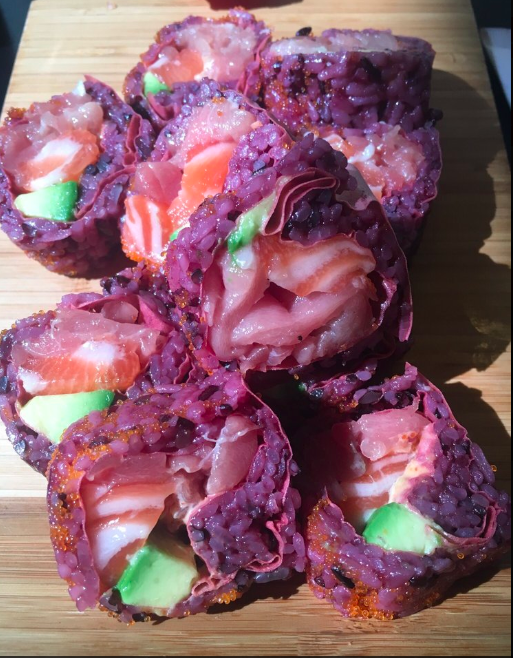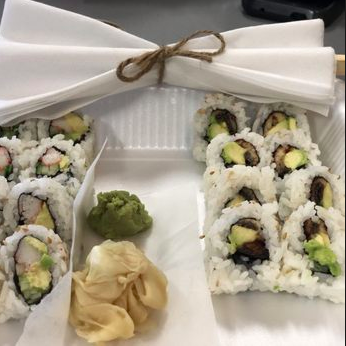The 3 Best Sushi Restaurants in Metro Phoenix- Sushi restaurants are everywhere in Metro Phoenix, casual and dramatic, fusion and traditional- you choose. Most restaurants are a blend of these characteristics. Here are the 3 Best Sushi Restaurants in Metro Phoenix.
Wonderfully addictive, cultural, and artistic — sushi remains a mystery to the uninitiated. Why would anyone want to pay so much for a few tidbits of raw fish? Unlike the supermarket sushi slopped out by chains in the West, a true sushi experience is unforgettable and difficult to recreate.
Metro Phoenix Homes for Sale
Downtown Sushi

Harumi Sushi
114 West Adams Street, Suite C101, Phoenix, AZ 85003
602-258-0131
Hours: Monday through Thursday 11 a.m. to 9 p.m.; Friday 11 a.m. to 10 p.m.; Saturday 4 to 10 p.m.; closed Sunday
This intimate, casual restaurant is a hot commodity in the Downtown Phoenix area and is one of the best Phoenix restaurants. The restaurant’s signature “purple” rice originates from nutrient-rich black rice which sets this one-of-a-kind restaurant apart from its competitors.
Not only is it sweeter but it’s more delicious taking the ordinary California roll to an extraordinary level. You can often find my family at the restaurant yelling, “OH MY GOD” as the attentive server brings out their signature roll ablaze. Try the seared salmon over rice, the spider roll, or the savory udon soup with vegetable tempura- you won’t be disappointed.
A mere $35.00 scores you a substantial, mix-and-match platter of maki rolls and nigiri. There probably won’t be any deep cuts or slightly obscure fish on your plate. However, it’s unnecessary as this adorable establishment more than delivers with their timeless pairings of cleanly carved fish and unique purple rice. Say hello to the lively owner, Juno, for us.
Uptown Sushi
Yasu Sushi Bistro
4316 East Cactus Road Rd.
Phoenix, AZ 85032
602-376-9823
Hours: Tuesday through Thursday 11:30 a.m. to 2 p.m.; 5:30 to 9 p.m.; Fridays 11:30 a.m. to 2 p.m.; 5:30 to 9:30 p.m.; Saturdays 5:30 to 9:30 p.m.; closed Sunday
No need to book a flight to Japan when you can simply enjoy a night out at Yasu. Clearly, this strip mall Japanese Restaurant will help you escape Phoenix and envision the distinct qualities of a quaint little sushi restaurant in Toyko. Owner Yasu Hashino opened Yasu Sushi Bistro in 2006. He creates sublime dishes as even a simple nigiri piece dazzles.
In addition, this Japanese eatery offers Japanese beer, shōchū, and artisanal sakes – all made by small producers, some impossible to find anywhere else in Arizona – to complement small plates that outshine any of the surrounding competitors.
Amazingly, the decadent bamboo-wrapped beef tongue is braised for eight hours with scallions and miso. It’s topped with a tableside hibachi. Each caramelized, captivating bite is beyond delectable. Furthermore, if you’re really looking for something unique, order the off-the-menu omakase – loosely translated as something like “I’m in your hands.” You can order a la carte or try the multi-course dinner created with luxurious and sometimes hard-to-come-by ingredients the chef selects specifically for you.
Favorites include: hay-smoked oysters, chawanmushi, a savory custard fortified with edamame, or jidori chicken, and the shimeji mushrooms, as delicate as fairy wands, bigeye tuna, marinated first in soy, sweet sake and yuzu kosho (a paste of chile peppers, citrus peel, garlic, salt and pepper) wrapped in silvery, rose-tinted slices of raw Japanese red snapper, topped with Santa Barbara sea urchin and surrounded by quivering cubes of dashi gelée.
Chandler Sushi

Shimogamo
2051 West Warner Road #14, Chandler 85224
480-899-7191
Hours: Monday through Thursday 5:30 to 9:30 p.m.; Friday 11:30 a.m. to 2 p.m., 5 to 10 p.m.; Saturday 5 to 10 p.m.; Sunday 5 to 9 p.m.
Notably, Chandler is known for its Asian food and Shimogamo is certainly no exception. It is a white-tablecloth restaurant tucked into a sleepy-looking shopping plaza near the intersection of Dobson and Warner roads in Chandler. It serves refined and creative sushi in the East Valley.
Moreover, try the restaurant’s signature Shimogamo roll, which features panko shrimp colorfully garnished with orange-hued tobiko (flying fish roe), and brilliantly accented with fresh citrus. The Zen roll, which brings together spicy yellowtail, yamagobo (pickled burdock root), and shishito peppers, is memorable and delicious. If you have an appreciation for nigiri topped with harder-to-find fish like sea urchin and escolar, you’ll find it here. With this in mind, reservations are suggested.
? Interesting Facts about Sushi
Sushi Originated Outside of Japan
Although the Japanese get full credit for what we call sushi today, the inspiration for sushi is thought to have started in Southeast Asia. Nare-zushi, a fermented fish wrapped in sour rice, originated somewhere around the Mekong River before spreading into China and later Japan.
Hanaya Yohei invented the modern-day concept of sushi sometime around the end of the Edo period sometime in the mid-1800s.
Once upon a time, sushi didn’t require a platinum credit card to enjoy. Sushi caught on originally as a cheap, quick snack to eat with the hands while enjoying a theater performance. Forget the popcorn: pass the sushi!
Real wasabi comes from the root of the wasabia japonica plant in Japan, not horseradish as is often substituted. The powerful burn of wasabi comes from naturally antimicrobial chemicals in the plant, the perfect compliment for killing potential microbes and parasites in raw seafood.
Authentic wasabi is pricey; sometimes sushi restaurants even charge for it. The stuff often provided in mid-range sushi restaurants is made from horseradish and mustard powder then colored green with artificial dyes to resemble the real deal.
If the type of sushi precedes the word, “sushi” mutates into “zushi” in the Japanese language. For instance, maki (what we call a sushi roll) is maki-zushi; nigiri (rice with a piece of sashimi pressed on top) is nigiri-zushi.
Puffer Fish Is the Most Dangerous Sashimi
Fugu, or pufferfish, contain lethal amounts of poison in its glands and organs. If a chef inadvertently scrapes one with a knife while preparing sashimi, he could potentially kill his own customer. To be certified to work with fugu sashimi, chefs in Japan must undergo a rigorous training and certification process — then eat their own finished product! And yes, there have been deaths during the final exams.
For centuries, the only law pertaining to the Emperor of Japan is that he can never eat fugu because of the risk involved.
Maki-zushi Gets Its Name From the Mat
The bamboo mat that gives sushi rolls their cylindrical shape is called a makisu in Japanese. While sushi rolls are the most popular form of sushi in the West, the Japanese often prefer nigiri — a piece of fish pressed on top of a strip of rice by hand.
Maki-zushi Isn’t Always Rolled in Seaweed
Although we are most familiar with sushi wrapped in black nori (seaweed), maki-zushi is sometimes wrapped in soy paper, cucumber, or egg in Japan.
Sushi Is Supposed to Be Eaten With the Hands
True to its origins as a simple fast food, the correct way to eat sushi is with your fingers. Chopsticks are typically only used to eat sashimi — raw slices of fish.
Nigiri Is to Be Eaten Upside Down
Sushi connoisseurs recommend that nigiri, a slice of fish squeezed atop a strip of rice, is best enjoyed by turning it upside down to place the fish side on the tongue. Nigiri is typically eaten with the fingers rather than chopsticks so that you can keep it together and rotate it easier. Give it a try!
You Can Buy the Chef a Drink
At the end of an authentic sushi experience, you can offer to buy the chef a shot of sakein gratitude. If he accepts, you should have one with him. Aside from the shot, avoid distracting the chef with small talk or questions about the food — he needs to focus on the sharp knife in hand!
